【分析】2018年高考英语全国II卷真题解析
2018年高考真题——英语(全国卷II)(详解版)
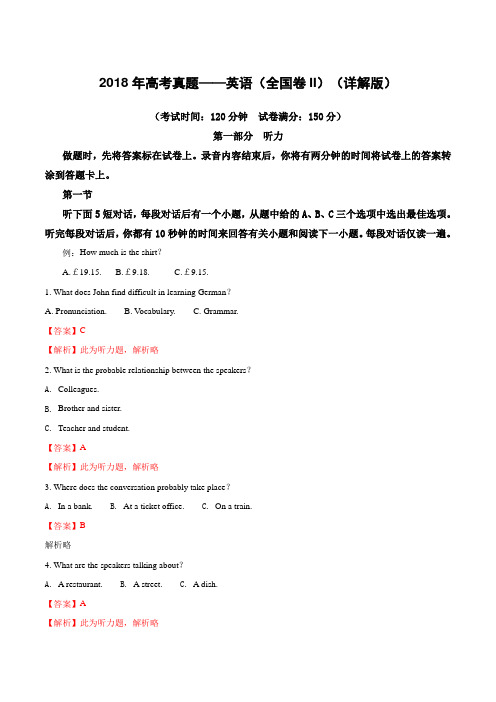
2018年高考真题——英语(全国卷II)(详解版)(考试时间:120分钟试卷满分:150分)第一部分听力做题时,先将答案标在试卷上。
录音内容结束后,你将有两分钟的时间将试卷上的答案转涂到答题卡上。
第一节听下面5短对话,每段对话后有一个小题,从题中给的A、B、C三个选项中选出最佳选项。
听完每段对话后,你都有10秒钟的时间来回答有关小题和阅读下一小题。
每段对话仅读一遍。
例:How much is the shirt?A.£19.15.B.£9.18.C.£9.15.1. What does John find difficult in learning German?A. Pronunciation.B. Vocabulary.C. Grammar.【答案】C【解析】此为听力题,解析略2. What is the probable relationship between the speakers?A. Colleagues.B. Brother and sister.C. Teacher and student.【答案】A【解析】此为听力题,解析略3. Where does the conversation probably take place?A. In a bank.B. At a ticket office.C. On a train.【答案】B解析略4. What are the speakers talking about?A. A restaurant.B. A street.C. A dish.【答案】A【解析】此为听力题,解析略5. What does the woman think of her interview?A. It was tough.B. It was interesting.C. It was successful.【答案】C【解析】此为听力题,解析略第二节听下面5段对话或独白,每段对话或独白后有几个小题,从题中所给的A、B、C三个选项中选出最佳选项。
2018高考全国II卷 英语试卷答案及解析
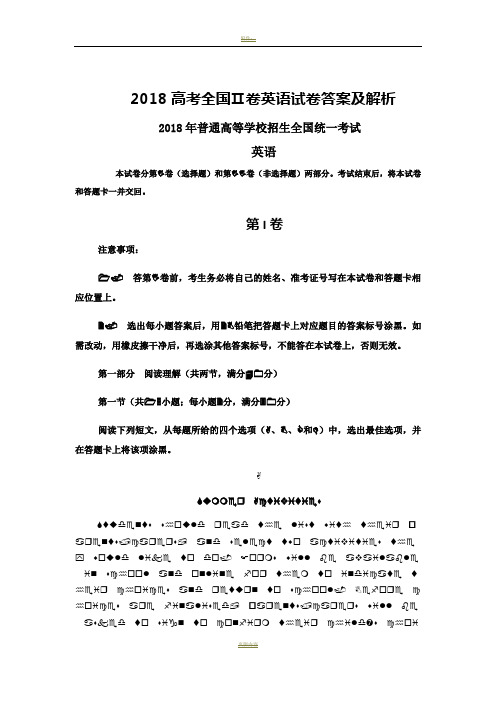
2018高考全国Ⅱ卷英语试卷答案及解析2018年普通高等学校招生全国统一考试英语本试卷分第✋卷(选择题)和第✋✋卷(非选择题)两部分。
考试结束后,将本试卷和答题卡一并交回。
第I卷注意事项: 答第✋卷前,考生务必将自己的姓名、准考证号写在本试卷和答题卡相应位置上。
选出每小题答案后,用 铅笔把答题卡上对应题目的答案标号涂黑。
如需改动,用橡皮擦干净后,再选涂其他答案标号,不能答在本试卷上,否则无效。
第一部分 阅读理解(共两节,满分 分)第一节(共 小题;每小题 分,满分 分)阅读下列短文,从每题所给的四个选项(✌、 、 和 )中,选出最佳选项,并在答题卡上将该项涂黑。
✌◆❍❍♏❒ ✌♍♦♓❖♓♦♓♏♦♦◆♎♏⏹♦♦ ♦♒☐◆●♎ ❒♏♋♎ ♦♒♏ ●♓♦♦ ♦♓♦♒ ♦♒♏♓❒ ☐♋❒♏⏹♦♦♍♋❒♏❒♦ ♋⏹♎ ♦♏●♏♍♦ ♦♦☐ ♋♍♦♓❖♓♦♓♏♦ ♦♒♏⍓ ♦☐◆●♎ ●♓♏ ♦☐ ♎☐ ☞☐❒❍♦ ♦♓●● ♌♏ ♋❖♋♓●♋♌●♏ ♓⏹ ♦♍♒☐☐● ♋⏹♎ ☐⏹●♓⏹♏ ♐☐❒ ♦♒♏❍ ♦☐ ♓⏹♎♓♍♋♦♏ ♦♒♏♓❒ ♍♒☐♓♍♏♦ ♋⏹♎ ❒♏♦◆❒⏹ ♦☐ ♦♍♒☐☐● ♏♐☐❒♏ ♍♒☐♓♍♏♦ ♋❒♏ ♐♓⏹♋●♓♦♏♎ ☐♋❒♏⏹♦♦♍♋❒♏❒♦ ♦♓●● ♌♏ ♋♦♏♎ ♦☐ ♦♓♑⏹ ♦☐ ♍☐⏹♐♓❒❍ ♦♒♏♓❒ ♍♒♓●♎❼♦ ♍♒☐♓♍♏♦ ♒♓♍♒ ♋♍♦♓❖♓♦⍓ ♦♓●● ⍓☐◆ ♍♒☐☐♦♏ ♓♐ ⍓☐◆ ♦♋⏹♦ ♦☐ ♑☐ ♍♋❍☐♓⏹♑✍✌ ✞❆ ☞ ❆ ♒♋♦ ♦♓●● ♦♒♏ ♦♦◆♎♏⏹♦♦ ♎☐ ☐⏹ ❆◆♏♦♎♋⍓ ♦♓♦♒ ❒♦ ♓●♦☐⏹✍✌ ❆❒♋❖♏● ♦☐ ☹☐⏹♎☐⏹ ♏♏ ♋ ☐♋❒♋♎♏ ♋⏹♎ ♐♓❒♏♦☐❒♦ ❆☐◆❒ ♍♏⏹♦❒♋● ♋❒♓♦ ✞♓♦♓♦ ♦♒♏ ✋ ♌♋♦♦●♏♐♓♏●♎♦ ☟☐♦ ●☐⏹♑ ♎☐♏♦ ☐♦♦⍓ ♋♌☐◆♦ ☐♦♦♏❒ ●♋♦♦✍✌ ❆♦☐ ♎♋⍓♦ ☞☐◆❒ ♎♋⍓♦ ☞♓❖♏ ♎♋⍓♦ ⏹♏ ♦♏♏文体:应用文主题:文章主要提供给了孩子们四种不同类型的夏日活动以及相关具体信息。
2018高考全国ii卷英语试卷答案及解析
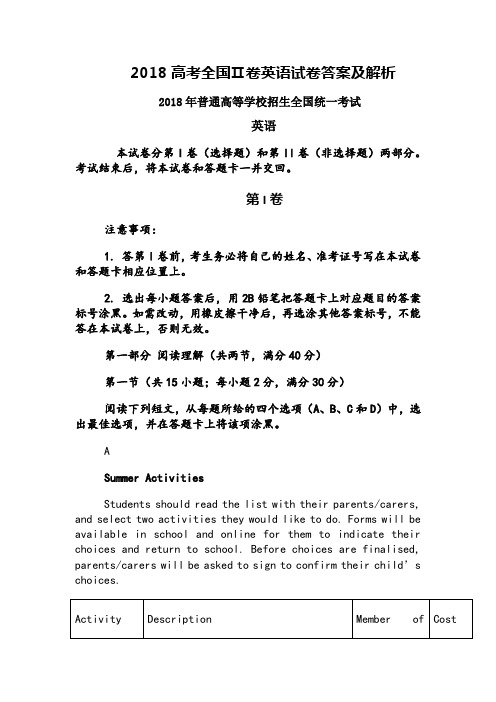
2018高考全国Ⅱ卷英语试卷答案及解析2018年普通高等学校招生全国统一考试英语本试卷分第I卷(选择题)和第II卷(非选择题)两部分。
考试结束后,将本试卷和答题卡一并交回。
第I卷注意事项:1. 答第I卷前,考生务必将自己的姓名、准考证号写在本试卷和答题卡相应位置上。
2. 选出每小题答案后,用2B铅笔把答题卡上对应题目的答案标号涂黑。
如需改动,用橡皮擦干净后,再选涂其他答案标号,不能答在本试卷上,否则无效。
第一部分阅读理解(共两节,满分40分)第一节(共15小题;每小题2分,满分30分)阅读下列短文,从每题所给的四个选项(A、B、C和D)中,选出最佳选项,并在答题卡上将该项涂黑。
ASummer ActivitiesStudents should read the list with their parents/carers, and select two activities they would like to do. Forms will be available in school and online for them to indicate their choices and return to school. Before choices are finalised, parents/carers will be asked to sign to confirm their child’s choices.21. Which activity will you choose if you want to go campingA. OUTB. WBPC. CRFD. POT22. What will the students do on Tuesday with Mrs WilsonA. Travel to London.B. See a parade and fireworks.C. Tour central Paris.D. Visit the WWI battlefields.23. How long does Potty about Potter lastA. Two days.B. Four days.C. Five days.D. One week.文体:应用文主题:文章主要提供给了孩子们四种不同类型的夏日活动以及相关具体信息。
2018年高考真题英语(全国卷II) Word版含解析

绝密★启用前2018年普通高等学校招生全国统一考试英语(考试时间:120分钟试卷满分:150分)注意事项:1.答卷前,考生务必将自己的姓名、准考证号填写在答题卡上。
2.作答时,务必将答案写在答题卡上,写在本试卷及草稿纸上无效。
3.考试结束后,将本试卷和答题卡一并交回。
第一部分听力做题时,先将答案标在试卷上。
录音内容结束后,你将有两分钟的时间将试卷上的答案转涂到答题卡上。
第一节听下面5短对话,每段对话后有一个小题,从题中给的A、B、C三个选项中选出最佳选项。
听完每段对话后,你都有10秒钟的时间来回答有关小题和阅读下一小题。
每段对话仅读一遍。
例:How much is the shirt?A.£19.15.B.£9.18.C.£9.15.1.What does John find difficult in learning German?A.Pronunciation.B.Vocabulary.C.Grammar.【答案】C【解析】此为听力题,解析略2.What is the probable relationship between the speakers?A.Colleagues.B.Brother and sister.C.Teacher and student.【答案】A【解析】此为听力题,解析略3.Where does the conversation probably take place?A.In a bank.B.At a ticket office.C.On a train.【答案】B解析略4.What are the speakers talking about?A.A restaurant.B.A street.C.A dish.【答案】A【解析】此为听力题,解析略5.What does the woman think of her interview?A.It was tough.B.It was interesting.C.It was successful.【答案】C【解析】此为听力题,解析略第二节听下面5段对话或独白,每段对话或独白后有几个小题,从题中所给的A、B、C三个选项中选出最佳选项。
2018年高考英语全国2卷真题及答案(word版) 含写作和详细解析
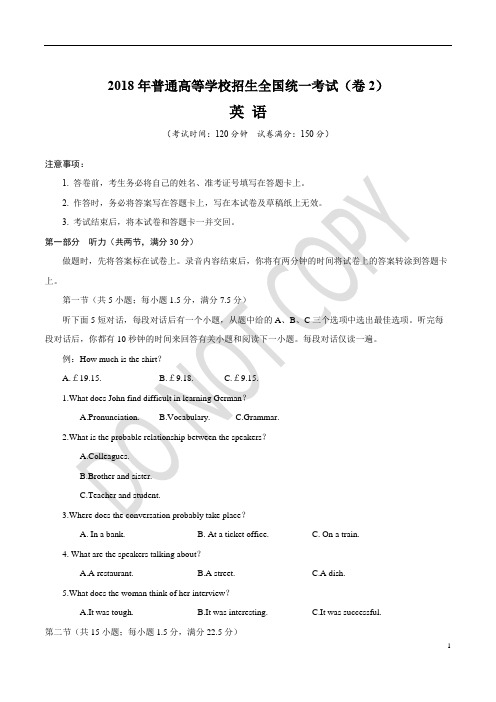
2018年普通高等学校招生全国统一考试(卷2)英语(考试时间:120分钟试卷满分:150分)注意事项:1. 答卷前,考生务必将自己的姓名、准考证号填写在答题卡上。
2. 作答时,务必将答案写在答题卡上,写在本试卷及草稿纸上无效。
3. 考试结束后,将本试卷和答题卡一并交回。
第一部分听力(共两节,满分30分)做题时,先将答案标在试卷上。
录音内容结束后,你将有两分钟的时间将试卷上的答案转涂到答题卡上。
第一节(共5小题;每小题1.5分,满分7.5分)听下面5短对话,每段对话后有一个小题,从题中给的A、B、C三个选项中选出最佳选项。
听完每段对话后,你都有10秒钟的时间来回答有关小题和阅读下一小题。
每段对话仅读一遍。
例:How much is the shirt?A.£19.15.B.£9.18.C.£9.15.1.What does John find difficult in learning German?A.Pronunciation.B.Vocabulary.C.Grammar.2.What is the probable relationship between the speakers?A.Colleagues.B.Brother and sister.C.Teacher and student.3.Where does the conversation probably take place?A. In a bank.B. At a ticket office.C. On a train.4. What are the speakers talking about?A.A restaurant.B.A street.C.A dish.5.What does the woman think of her interview?A.It was tough.B.It was interesting.C.It was successful.第二节(共15小题;每小题1.5分,满分22.5分)听下面5段对话或独白,每段对话或独白后有几个小题,从题中所给的A、B、C三个选项中选出最佳选项。
(完整word)2018全国高考新课标2卷英语及答案解析

绝密★启用前2018年普通高等学校招生全国统一考试英语(考试时间:注意事项:1. 答卷前,考生务必将自己的姓名、准考证号填写在答题卡上。
2. 作答时,务必将答案写在答题卡上,写在本试卷及草稿纸上无效。
3. 考试结束后,将本试卷和答题卡一并交回。
第一部分听力(共两节,满分30分)做题时,先将答案标在试卷上。
录音内容结束后,你将有两分钟的时间将试卷上的答案转涂到答题卡上。
第一节(共5小题;每小题1.5分,满分7.5分)听下面5短对话,每段对话后有一个小题,从题中给的A、B、C三个选项中选出最佳选项。
听完每段对话后,你都有10秒钟的时间来回答有关小题和阅读下一小题。
每段对话仅读一遍。
例:How much is the shirt?A.£19.15.B.£9.18.C.£9.15.1.What does John find difficult in learning German?A.Pronunciation.B.Vocabulary.C.Grammar.2.What is the probable relationship between the speakers?A.Colleagues.B.Brother and sister.C.Teacher and student.3.Where does the conversation probably take place?A. In a bank.B. At a ticket office.C. On a train.4. What are the speakers talking about?A.A restaurant.B.A street.C.A dish.5.What does the woman think of her interview?A.It was tough.B.It was interesting.C.It was successful.第二节(共15小题;每小题1.5分,满分22.5分)听下面5段对话或独白,每段对话或独白后有几个小题,从题中所给的A、B、C三个选项中选出最佳选项。
2018年高考英语全国卷2含答案解析
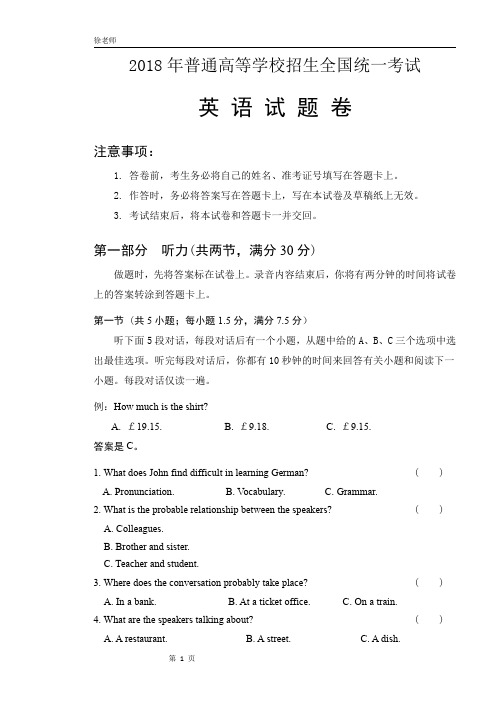
徐老师2018年普通高等学校招生全国统一考试英语试题卷注意事项:1.答卷前,考生务必将自己的姓名、准考证号填写在答题卡上。
2.作答时,务必将答案写在答题卡上,写在本试卷及草稿纸上无效。
3.考试结束后,将本试卷和答题卡一并交回。
第一部分听力(共两节,满分30分)做题时,先将答案标在试卷上。
录音内容结束后,你将有两分钟的时间将试卷上的答案转涂到答题卡上。
第一节(共5小题;每小题1.5分,满分7.5分)听下面5段对话,每段对话后有一个小题,从题中给的A、B、C三个选项中选出最佳选项。
听完每段对话后,你都有10秒钟的时间来回答有关小题和阅读下一小题。
每段对话仅读一遍。
例:How much is the shirt?A.£19.15.B.£9.18.C.£9.15.答案是C。
1.What does John find difficult in learning German?()A.Pronunciation.B.Vocabulary.C.Grammar.2.What is the probable relationship between the speakers?()A.Colleagues.B.Brother and sister.C.Teacher and student.3.Where does the conversation probably take place?()A.In a bank.B.At a ticket office.C.On a train.4.What are the speakers talking about?()A.A restaurant.B.A street.C.A dish.第1页5.What does the woman think of her interview?()A.It was tough.B.It was interesting.C.It was successful.第二节(共15小题;每小题1.5分,满分22.5分)听下面5段对话或独白,每段对话或独白后有几个小题,从题中所给的A、B、C三个选项中选出最佳选项。
2018年高考真题英语(全国卷II) Word版含解析
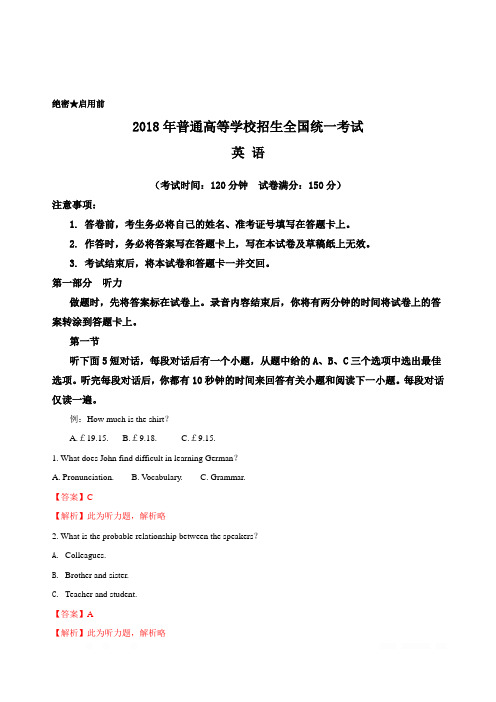
绝密★启用前2018年普通高等学校招生全国统一考试英语(考试时间:120分钟试卷满分:150分)注意事项:1. 答卷前,考生务必将自己的姓名、准考证号填写在答题卡上。
2. 作答时,务必将答案写在答题卡上,写在本试卷及草稿纸上无效。
3. 考试结束后,将本试卷和答题卡一并交回。
第一部分听力做题时,先将答案标在试卷上。
录音内容结束后,你将有两分钟的时间将试卷上的答案转涂到答题卡上。
第一节听下面5短对话,每段对话后有一个小题,从题中给的A、B、C三个选项中选出最佳选项。
听完每段对话后,你都有10秒钟的时间来回答有关小题和阅读下一小题。
每段对话仅读一遍。
例:How much is the shirt?A.£19.15.B.£9.18.C.£9.15.1. What does John find difficult in learning German?A. Pronunciation.B. V ocabulary.C. Grammar.【答案】C【解析】此为听力题,解析略2. What is the probable relationship between the speakers?A. Colleagues.B. Brother and sister.C. Teacher and student.【答案】A【解析】此为听力题,解析略3. Where does the conversation probably take place?A. In a bank.B. At a ticket office.C. On a train.【答案】B解析略4. What are the speakers talking about?A. A restaurant.B. A street.C. A dish.【答案】A【解析】此为听力题,解析略5. What does the woman think of her interview?A. It was tough.B. It was interesting.C. It was successful.【答案】C【解析】此为听力题,解析略第二节听下面5段对话或独白,每段对话或独白后有几个小题,从题中所给的A、B、C三个选项中选出最佳选项。
2018年高考真题——英语(全国卷Ⅱ)+Word版含详细解析
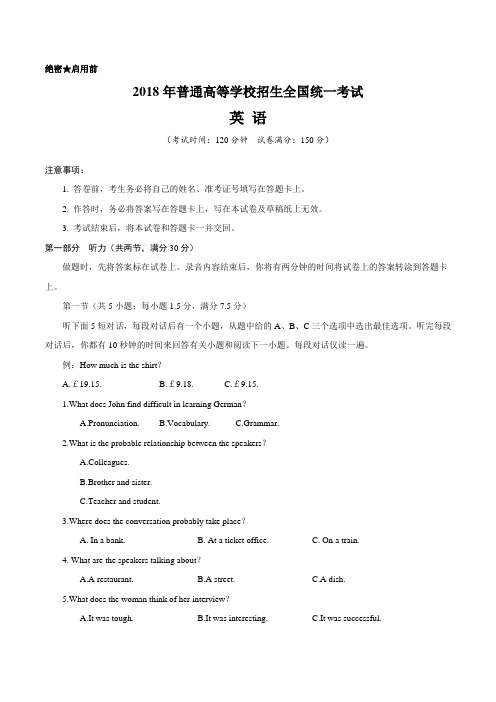
绝密★启用前2018年普通高等学校招生全国统一考试英语(考试时间:120分钟试卷满分:150分)注意事项:1. 答卷前,考生务必将自己的姓名、准考证号填写在答题卡上。
2. 作答时,务必将答案写在答题卡上,写在本试卷及草稿纸上无效。
3. 考试结束后,将本试卷和答题卡一并交回。
第一部分听力(共两节,满分30分)做题时,先将答案标在试卷上。
录音内容结束后,你将有两分钟的时间将试卷上的答案转涂到答题卡上。
第一节(共5小题;每小题1.5分,满分7.5分)听下面5短对话,每段对话后有一个小题,从题中给的A、B、C三个选项中选出最佳选项。
听完每段对话后,你都有10秒钟的时间来回答有关小题和阅读下一小题。
每段对话仅读一遍。
例:How much is the shirt?A.£19.15.B.£9.18.C.£9.15.1.What does John find difficult in learning German?A.Pronunciation.B.Vocabulary.C.Grammar.2.What is the probable relationship between the speakers?A.Colleagues.B.Brother and sister.C.Teacher and student.3.Where does the conversation probably take place?A. In a bank.B. At a ticket office.C. On a train.4. What are the speakers talking about?A.A restaurant.B.A street.C.A dish.5.What does the woman think of her interview?A.It was tough.B.It was interesting.C.It was successful.第二节(共15小题;每小题1.5分,满分22.5分)听下面5段对话或独白,每段对话或独白后有几个小题,从题中所给的A、B、C三个选项中选出最佳选项。
2018高考全国II卷英语试卷解析.docx
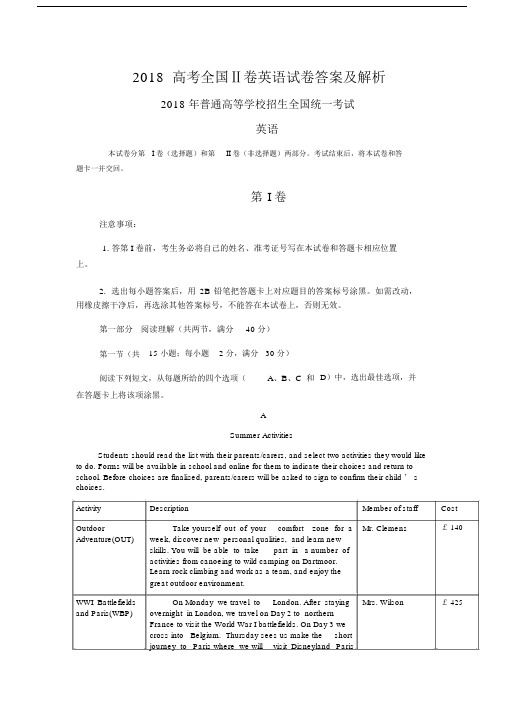
2018 高考全国Ⅱ卷英语试卷答案及解析2018 年普通高等学校招生全国统一考试英语本试卷分第I 卷(选择题)和第II 卷(非选择题)两部分。
考试结束后,将本试卷和答题卡一并交回。
第I 卷注意事项:1. 答第 I 卷前,考生务必将自己的姓名、准考证号写在本试卷和答题卡相应位置上。
2.选出每小题答案后,用2B 铅笔把答题卡上对应题目的答案标号涂黑。
如需改动,用橡皮擦干净后,再选涂其他答案标号,不能答在本试卷上,否则无效。
第一部分阅读理解(共两节,满分40 分)第一节(共15 小题;每小题 2 分,满分30 分)阅读下列短文,从每题所给的四个选项(A、B、C和D)中,选出最佳选项,并在答题卡上将该项涂黑。
ASummer ActivitiesStudents should read the list with their parents/carers, and select two activities they would liketo do. Forms will be available in school and online for them to indicate their choices and return toschool. Before choices are finalised, parents/carers will be asked to sign to confirm their child ’ schoices.Activity Description Member of staff CostOutdoor Take yourself out of your comfort zone for a Mr. Clemens£ 140 Adventure(OUT)week, discover new personal qualities, and learn newskills. You will be able to take part in a number ofactivities from canoeing to wild camping on Dartmoor.Learn rock climbing and work as a team, and enjoy thegreat outdoor environment.WWI Battlefields On Monday we travel to London. After staying Mrs. Wilson£ 425 and Paris(WBP)overnight in London, we travel on Day 2 to northernFrance to visit the World War I battlefields. On Day 3 wecross into Belgium. Thursday sees us make the shortjourney to Paris where we will visit Disneyland Parispark, staying until late to see the parade and thefireworks. Our final day, Friday, sees us visit central Parisand tour the main sights.Crafty Foxes(CRF)Four days of product design centred around Mrs. Goode£ 30 textiles. Making lovely objects using recycled and madematerials. Bags, cushions and decorations⋯ Learn skillsand leave with modern and unusual textiles.Pottyabout Potter(POT)Visit Warner Bros Studio, shop stop to buy picnic,Miss Drake£ 150 stay overnight in an approved Youth Hostel inStreatley-on-Thames, guided tour of Oxford to see thefilm locations,picnic lunch outside Oxford’ sChristchurch, boating on the River Cherwell throughthe University Parks, before heading back to Exeter.21. Which activity will you choose if you want to go camping?A. OUTB. WBPC. CRFD. POT22. What will the students do on Tuesday with Mrs Wilson?A. Travel to London.B. See a parade and fireworks.C. Tour central Paris.D. Visit the WWI battlefields.23. How long does Potty about Potter last?A. Two days.B. Four days.C. Five days.D. One week.文体:用文主:文章主要提供了孩子四种不同型的夏日活以及相关具体信息。
2018年高考全国II卷真题及解析-英语

2018年高考全国II卷真题及解析-英语第二部分阅读理解(共两节,满分40分)第一节(共15小题;每小题2分,满分30分)阅读下列短文,从每题所给的A、B、C和D四个选项中,选出最佳选项.ASummer ActivitiesStudents should read the list with their parents/carers, and select two activities they would like to do. Forms will be available in school and online for them to indicate their choices and return to school. Before choices are finalized . parents/ carers will be asked to sign to confirm their child's choices21. Which activity will you choose if you want to go camping?A. OUT.B. WBP.C. CRF.D. POT.22. What will the students do on Tuesday with Mrs. Wilson?A. Travel to London.B. See a parade and fireworks.C. Tour central Paris.D. Visit the WWI battlefields.23. How long does Potty about Potter last?A. Two days.B. Four days.C. Five days.D. One week.BMany of us love July because it's the month when nature's berries and stone fruits are in abundance. These colourful and sweet jewels from British Columbia's fields are little powerhouses of nutritional protection.Of the common berries, strawberries are highest in vitamin C, although, because of their seeds, raspberries contain a little more protein (蛋白质), iron and zinc(not that fruits have much protein). Blueberries are particularly high in antioxidants(抗氧化物质). The yellow and orange stone fruits such as peaches are high in the carotenoids we turn into vitamin A and which are antioxidants, As for cherries (樱花). they are so delicious who cares? However ,they are rich in vitamin C.When combined with berries or slices of other fruits. frozen bananas make an excellent base for thick, cooling fruit shakes and low fat “ice cream”. For this purpose, select ripe bananas for freezing as they are much sweeter. Remove the skin and place them in plastic bags or containers and freeze If you like, a squeeze of fresh lemon juice on the bananas will prevent them turning brown. Frozen bananas will last several weeks, depending on their ripeness and the temperature of the freezer.If you have a juicer, you can simply feed in frozen bananas and some berries or sliced fruit. Out comes a“soft-serve” creamy dessert, to be eaten right away. This makes a fun activity for a children's party; they love feeding the fruit and frozen bananas into the top of the machine and watching the ice cream come out below.24. What does the author seem to like about cherries?A. They contain protein.B. They are high in vitamin A.C. They have a pleasant taste.D. They are rich in antioxidants.25. Why is fresh lemon juice used in freezing bananas?A. To make them smell better.B. To keep their colour.C. To speed up their ripeningD. To improve their nutrition.26. What is “a juicer”in the last paragraph?A. A dessert.B. A drink.C. A container.D. A machine.27. From which is the text probably taken?A. A biology textbook.B. A health magazine.C. A research paper.D. A travel brochure.CTeens and younger children are reading a lot less for fun, according to a Common Sense Media report published Monday.While the decline over the past decade is steep for teen readers, some data in the report shows that reading remains a big part of many children's lives, and indicates how parents might help encourage more reading.According to the report's key findings, “the proportion(比例) who say they‘hardly ever’read for fun has gone from 8 percent of 13-year-olds and 9 percent of 17-year-olds in 1984 to 22 percent and 27 percent respectively today.”The report data shows that pleasure reading levels for younger children. ages 2-8, remain largely the same. But the amount of time spent in reading each session has declined, from closer to an hour or more tocloser to a half hour per session.When it comes to technology and reading,the report does little to counsel (建议) parents looking for data about the effect of e-readers and tablets on reading. It does point out that many parents still limit electronic reading, mainly due to concerns about increased screen time.The most hopeful data shared in the report shows clear evidence of parents serving as examples and important guides for their kids when it comes to reading, Data shows that kids and teens who do read frequently, compared to infrequent readers, have more books in the home, more books purchased for them, parents who read more often, and parents who set aside time for them to read.As the end of school approaches, and school vacation reading lists loom (逼近) ahead ,parents might take this chance to step in and make their own summer reading list and plan a family trip to the library or bookstore.28. What is the Common Sense Media report probably about?A. Children’s reading habits.B. Quality of children's books.C. Children’s after-class activities.D. parent-child relationships.29. Where can you find the data that best supports“children are reading a lot less for fun”?A. In paragraph 2.B. In paragraph 3.C. In paragraph 4D. In paragraph 5.30. Why do many parents limit electronic reading?A. E-books are of poor quality.B. It could be a waste of time.C. It may harm children’s health.D. E-readers are expensive.31. How should parents encourage their children to read more?A. Act as role models for themB. Ask them to write book reportsC. Set up reading groups for themD. Talk with their reading class teachersDWe've all been there: in a lift, in line at the bank or on an airplane, surrounded by people who are, like us, deeply focused on their smartphones or, worse, struggling with the uncomfortable silence.What's the problem? It's possible that we all have compromised conversational intelligence. It's more likely that none of us start a conversation because it's awkward and challenging, or we think it's annoying and unnecessary. But the next time you find yourself among strangers, consider that small talk is worth the trouble .Experts say it's an invaluable social practice that results in big benefits.Dismissing small talk as unimportant is easy, but we can't forget that deep relationships wouldn't even exist if it weren't for casual conversation. Small talk is the grease (润滑剂)for social communication, says Bernardo Carducci, director of the Shyness Research Institute at Indiana University Southeast ."Almost every great love story and each big business deal begins with small talk, "he explains. "The key to successful small talk is learning how to connect with others, not just communicate with them.”In a 2014 study, Elizabeth Dunn, associate professor of psychology at UBC, invited people on their way into a coffee shop. One group was asked to seek out an interaction(互动) with its waiter, the other, to speak only when necessary. The results showed that those who chatted with theirserver reported significantly higher positive feelings and a better coffee shop experience. "it's not that talking to the waiter is better than talking to your husband.”says Dunn ."But interactions with peripheral (边缘的)members of our social network matter for ourwell-being also.”Dunn believes that people who reach out to strangers feel a significantly greater sense of belonging, a bond with others. Carducci believes developing such a sense of belonging starts with small talk. "Small talk is the basis of good manners, ”he says.32. What phenomenon is described in the first paragraph?A.Addiction to smartphonesB .Inappropriate behaviours in public placesC. Absence of communication between strangers.D .Impatience with slow service33. What is important for successful small talk according to Carducci?A. Showing good manners.B. Relating to other people.C. Focusing on a topic.D Making business deals34. What does the coffee-shop study suggest about small talk?A. It improves family relationships.B. It raises people's confidence.C. It matters as much as a formal talk.D. It makes people feel good.35. What is the best title for the text?A. Conversation CountsB. Ways of Making Small TalkC. Benefits of Small TalkD. Uncomfortable Silence第二节(共5小题:每小题2分,满分10分)根据短文内容,从短文后的选项中选出能填入空白处的最佳选项。
2018高考全国II卷-英语试卷答案及解析
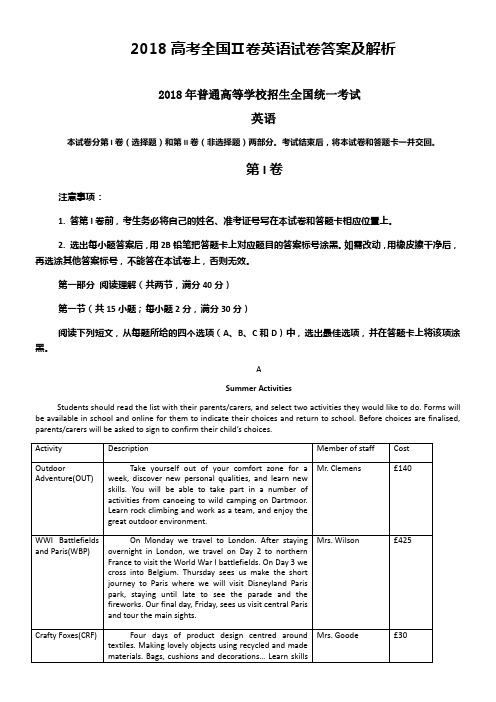
2018高考全国Ⅱ卷英语试卷答案及解析2018年普通高等学校招生全国统一考试英语本试卷分第I卷(选择题)和第II卷(非选择题)两部分。
考试结束后,将本试卷和答题卡一并交回。
第I卷注意事项:1. 答第I卷前,考生务必将自己的姓名、准考证号写在本试卷和答题卡相应位置上。
2. 选出每小题答案后,用2B铅笔把答题卡上对应题目的答案标号涂黑。
如需改动,用橡皮擦干净后,再选涂其他答案标号,不能答在本试卷上,否则无效。
第一部分阅读理解(共两节,满分40分)第一节(共15小题;每小题2分,满分30分)阅读下列短文,从每题所给的四个选项(A、B、C和D)中,选出最佳选项,并在答题卡上将该项涂黑。
ASummer ActivitiesStudents should read the list with their parents/carers, and select two activities they would like to do. Forms will be available in school and online for them to indicate their choices and return to school. Before choices are finalised, parents/carers wil l be asked to sign to confirm their child’s choices.A. OUTB. WBPC. CRFD. POT22. What will the students do on Tuesday with Mrs Wilson?A. Travel to London.B. See a parade and fireworks.C. Tour central Paris.D. Visit the WWI battlefields.23. How long does Potty about Potter last?A. Two days.B. Four days.C. Five days.D. One week.文体:应用文主题:文章主要提供给了孩子们四种不同类型的夏日活动以及相关具体信息。
2018高考全国卷Ⅱ英语试题[版含答案解析]
![2018高考全国卷Ⅱ英语试题[版含答案解析]](https://img.taocdn.com/s3/m/9e140c5c1eb91a37f1115c83.png)
2018年普通高等学校招生全国统一考试英语(考试时间:120分钟试卷满分:150分)第二部分阅读理解(共两节,满分40分)第一节 (共15小题;每小题2分,满分30分)阅读下列短文,从每题所给的A、B、C和D四个选项中,选出最佳选项。
ASummer ActivitiesStudents should read the list with their parents/careers, and select two activities theywould like to do. Forms will be available in school and online for them to indicate their choices and return to school. Before choices are finalised, parents/careers will be asked tosign to confirm their child’s choices.21.Which activity will you choose if you want to go camping?A.OUT.B.WBP.C.CRF.D.POT.22.What will the students do on Tuesday with Mrs. Wilson?A. Travel to London.B. See a parade and fireworks.C. Tour central Paris.D. Visit the WWI battlefields.23.How long does Potty about Potter last?A. Two days.B. Four days.C. Five days.D. One week.BMany of us love July because it’s the month when nature’s berries and stone fruits are in abundance. These colourful and sweet jewels form British Columbia’s fields are little powerhouses of nutritional protection.Of the common berries, strawberries are highest in vitamin C, although, because of their seeds, raspberries contain a little more protein (蛋白质), iron and zinc (not that fruits have much protein). Blueberries are particularly high in antioxidants (抗氧化物质). The yellow and orange stone fruits such as peaches are high in the carotenoids we turn into vitamin A and which are antioxidants. As for cherries (樱桃), they are so delicious who cares? However, they are rich in vitamin C.When combined with berries of slices of other fruits, frozen bananas make an excellent base for thick, cooling fruit shakes and low fat “ice cream”. For this purpose, select ripe bananas for freezing as they are much sweeter. Remove the skin and place them in plastic bags or containers and freeze. If you like, a squeeze of fresh lemon juice on the bananas will prevent them turning brown. Frozen bananaswill last several weeks, depending on their ripeness and the temperature of the freezer.If you have a juicer, you can simply feed in frozen bananas and some berries or sliced fruit. Out comes a “soft-serve” creamy dessert, to be eaten ri ght away. This makes a fun activity for a children’s party; they love feeding the fruit and frozen bananas into the top of the machine and watching the ice cream come out below.24. What does the author seem to like about cherries?A. They contain protein.B. They are high in vitamin A.C. They have a pleasant taste.D. They are rich in antioxidants.25. Why is fresh lemon juice used in freezing bananas?A. To make them smell better.B. To keep their colour.C. To speed up their ripening.D. To improve their nutrition.26. What is “a juicer” in the last paragraph?A. A dessert.B. A drink.C. A container.D. A machine.27. From which is the text probably taken?A. A biology textbook.B. A health magazine.C. A research paper.D. A travel brochure.CTeens and younger children are reading a lot less for fun, according to a Common Sense Media report published Monday.While the decline over the past decade is steep for teen readers, some data in the report shows that reading remains a big part of many children’s lives, and indicates how parents might help encourage more reading.According to the report’s key findings, “the proportion (比例) who say they ‘hardly ever’ read for fun has gone from 8 percent of 13-year-olds and 9 percent of 17-year-olds in 1984 to 22 percent and 27 percent respectively today.”The report data shows that pleasure reading levels for younger children, ages 2—8, remain largely the same. But the amount of time spent in reading each session has declined, from closer to an hour or more to closer to a half hour per session. When it comes to technology and reading, the report does little to counsel(建议) parents looking for data about the effect of e-readers and tablets on reading. It does point out that many parents still limit electronic reading, mainly due to concerns about increased screen time.The most hopeful data shared in the report shows clear evidence of parents serving as examples and important guides for their kids when it comes to reading. Data shows that kids and teens who do read frequently, compared to infrequent readers, have more books in the home, more books purchased for them, parents who read more often, and parents who set aside time for them to read.As the end of school approaches, and school vacation reading lists loom(逼近) ahead, parents might take this chance to step in and make their own summer reading list and plan a family trip to the library or bookstore.28. What is the Common Sense Media report probably about?A. Children’s reading habits.B. Quality of children’s books.C. Children’s after-class activities.D. Parent-child relationships.29. Where can you find the data that best supports "children are reading a lot less for fun"?A. In paragraph 2.B. In paragraph 3.C. In paragraph 4.D. In paragraph 5.30. Why do many parents limit electronic reading?A. E-books are of poor quality.B. It could be a waste of time.C. It may harm children’s health.D. E-readers are expensive.31. How should parents encourage their children to read more?A. Act as role models for them.B. Ask then to write book reports.C. Set up reading groups for them.D. Talk with their reading class teachers.DWe’ve all been there: in a lift, in line at the bank or on an airplane, surrounded by people who are, like us, deeply focused on their smartphones or, worse, struggling with the uncomfortable silence.What’s the problem? It’s possible that we all have compromised conversational intelligence. It’s more likely that none of us start a conversation because it’s awkward and challenging, or we think it’s annoying and unnecessary. But the next time you find yourself among strangers, consider that small talk is worth the trouble. Experts say it’s an invaluable soci al practice that results in big benefits.Dismissing small talk as unimportant is easy, but we can’t forget that deep relationships wouldn’teven exist if it weren’t for casual conversation. Small talk is the grease(润滑剂) for social communication, says Bernardo Carducci, director of the Shyness Research Institute at Indiana University Southeast. "Almost every great love story and each big business deal begins with small talk," he explains. "The key to successful small talk is learning how to connect with others, not just communicate with them."In a 2014 study, Elizabeth Dunn, associate professor of psychology at UBC, invited people on their way into a coffee shop. One group was asked to seek out an interaction(互动) with its waiter; the other, to speak only when necessary. The results showed that those who chatted with their server reported significantly higher positive feelings and a better coffee shop experience. "It’s not that talking to the waiter is better than talking to your husband," says Dunn. "Butinteractions with peripheral(边缘的) members of our social network matter for our well-being also."Dunn believes that people who reach out to strangers feel a significantly greater sense of belonging, a bond with others. Carducci believes developing such a sense of belonging starts with small talk. "Small talk is the basis of good manners," he says.32. What phenomenon is described in the first paragraph?A. Addiction to smartphones.B. Inappropriate behaviours in public places.C. Absence of communication between strangers.D. Impatience with slow service.33. What is important for successful small talk according to Carducci?A. Showing good manners.B. Relating to other people.C. Focusing on a topic.D. Making business deals.34. What does the coffee-shop study suggest about small talk?A. It improves family relationships.B. It raises people’s confidence.C. It matters as much as a formal talk.D. It makes people feel good.35. What is the best title for the text?A. Conversation CountsB. Ways of Making Small TalkC. Benefits of Small TalkD. Uncomfortable Silence第二节 (共5小题;每小题2分,满分10分)根据短文内容,从短文后的选项中选出能填入空白处的最佳选项。
2018高考英语试题[全国卷II] 答案解析
![2018高考英语试题[全国卷II] 答案解析](https://img.taocdn.com/s3/m/c2e0f5b6b9d528ea81c779d8.png)
2018年普通高等学校招生全国统一考试(全国II卷)英语注意事项:1. 答卷前,考生务必将自己的姓名、准考证号填写在答题卡上。
2. 回答选择题时,选出每小题答案后,用铅笔把答题卡上对应题目的答案标号涂黑。
如需改动,用橡皮擦干净后,再选涂其他答案标号。
回答非选择题时,将答案写在答题卡上,写在本试卷上无效。
3. 考试结束后,将本试卷和答题卡一并交回。
第一部分听力 (共两节,满分30分)做题时,先将答案标在试卷上。
录音内容结束后,你将有两分钟的时间将试卷上的答案转涂到答题卡上。
第一节(共5小题;每小题1.5分,满分7.5分)听下面5段对话。
每段对话后有一个小题,从题中所给的A、B、C三个选项中选出最佳选项。
听完每段对话后,你都有10秒钟的时间来回答有关小题和阅读下一小题。
每段对话仅读一遍。
例:How much is the shirt?A. £19. 15.B. £9. 18.C. £9. 15.答案是C。
1. What does John find difficult in learning German?A. Pronunciation.B. Vocabulary.C. Grammar.2. What is the probable relationship between the speakers?A. Colleagues.B. Brother and sister.C. Teacher and student.3. Where does the conversation probably take place?A. In a bank.B. At a ticket office.C. On a train.4. What are the speakers talking about?A. A restaurant.B. A street.C. A dish.5. What does the woman think of her interview?A. It was tough.B. It was interesting.C. It was successful.第二节(共15小题;每小题1.5分,满分22.5分)听下面5段对话或独白。
【最详尽解析】2018年高考英语全国2卷真题
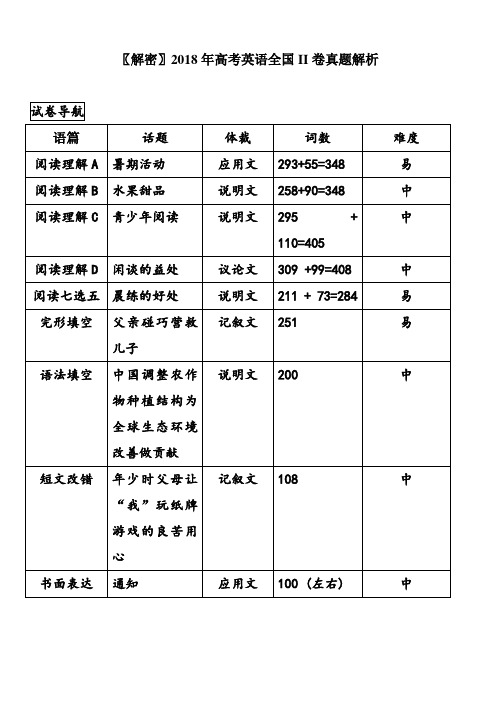
〖解密〗2018年高考英语全国II卷真题解析第二部分阅读理解(共两节,满分40分)第一节(共15小题;每小题2分,满分30分)阅读下列短文,从每题所给的A、B、C和D四个选项中,选出最佳选项。
ASummer ActivitiesStudents should read the list with their parents / carers, and select two activities they would like to do. Forms will be available in school and online for them to indicate their choices and return to school. Before choices are finalised, parents / carers will be asked to sign to confirm their child’s choices.21. Which activity will you choose if you want to go campingA. OUT.B. WBP.C. CRF.D. POT.22. What will the students do on Tuesday with Mrs. WilsonA. Travel to London.B. See a parade and fireworks.C. Tour central Paris.D. Visit the WWI battlefields.23. How long does Potty about Potter lastA. Two days.B. Four days.C. Five days.D. One week.他们希望参加的两种活动。
百科知识1. 基督教堂学院(Christchurch)是牛津大学最大学院。
- 1、下载文档前请自行甄别文档内容的完整性,平台不提供额外的编辑、内容补充、找答案等附加服务。
- 2、"仅部分预览"的文档,不可在线预览部分如存在完整性等问题,可反馈申请退款(可完整预览的文档不适用该条件!)。
- 3、如文档侵犯您的权益,请联系客服反馈,我们会尽快为您处理(人工客服工作时间:9:00-18:30)。
〖解密〗2018年高考英语全国II卷真题解析第二部分阅读理解(共两节,满分40分)第一节(共15小题;每小题2分,满分30分)阅读下列短文,从每题所给的A、B、C和D四个选项中,选出最佳选项。
ASummer ActivitiesStudents should read the list with their parents / carers, and select two activities they would like to do. Forms will be available in school and online for them to indicate their choices and return to school. Before choices are21. Which activity will you choose if you want to go camping?A. OUT.B. WBP.C. CRF.D. POT.22. What will the students do on Tuesday with Mrs. Wilson?A. Travel to London.B. See a parade and fireworks.C. Tour central Paris.D. Visit the WWI battlefields.23. How long does Potty about Potter last?A. Two days.B. Four days.C. Five days.D. One week.1. 基督教堂学院(Christchurch)是牛津大学最大学院。
基督教堂学院享有不称为College的特权,在牛津它通常被称为“The House”。
基督教堂学院与英国政治渊源很深,曾在内战时作为查理一世的临时首都,在近200年内产生了16位英国首相。
这里也是电影《哈利﹒波特》的重要取景地。
2. 查韦尔河(River Cherwell)是泰晤士河(River Thames)位于英格兰中部的主要支流,全长40英里,流经牛津大学城,最终在牛津西南方汇入泰晤士河。
答案与解析21. A 事实细节题由Outdoor Adventure (OUT)的内容中提到的You will be able to take part in a number of activities from canoeing to wild camping on Dartmoor.可知,如果想露营选OUT这一活动。
22. D 事实细节题由WWI Battlefields and Paris (WBP)的内容中提到的Mrs. Wilson以及On Monday we travel to London. After staying overnight in London, we travel on Day 2 to northern France to visit the World War I battlefields.可知学生们将在周二和威尔逊女士参观第一次世界大战的战场。
23. A 事实细节题由Potty about Potter (POT)的内容中提到的Visit Warner Bros Studio, shop stop to buy picnic, stay overnight … heading back to Exeter.可知,Potty about Potter活动持续两天。
BMany of us love July because it’s the month when nature’s berrie s and stone fruits are in abundance. These colourful and sweet jewels from British Columbia’s fields are little powerhouses of nutritional protection.Of the common berries, strawberries are highest in vitamin C, although, because of their seeds, raspberries contain a little more protein (蛋白质), iron and zinc (not that fruits have much protein). Blueberries are particularly high in antioxidants (抗氧化物质). The yellow and orange stone fruits such as peaches are high in the carotenoids we turn into vitamin A and which are antioxidants. As for cherries (樱桃), they are so delicious who cares? However, they are rich in vitamin C.When combined with berries or slices of other fruits, frozen bananas make an excellent base for thick, cooling fruit shakes and low fat “ice cream”. For this purpose, select ripe bananas for freezing as they are much sweeter. Remove the skin and place them in plastic bags or containers and freeze. If you like, a squeeze of fresh lemon juice on the bananas will prevent them turning brown. Frozen bananas will last several weeks, depending on their ripeness and the temperature of the freezer.If you have a juicer, you can simply feed in frozen bananas and some berries or sliced fruit. Out comes a “soft-serve” creamy dessert, to be eaten right away. This makes a fun activity for a children’s party; they love feeding the fruit and frozen bananas into the top of the machine and watching the ice cream come out below.24. What does the author seem to like about cherries?A. They contain protein.B. They are high in vitamin A.C. They have a pleasant taste.D. They are rich in antioxidants.25. Why is fresh lemon juice used in freezing bananas?A. To make them smell better.B. To keep their colour.C. To speed up their ripening.D. To improve their nutrition.26. What is “a juicer” in the last paragraph?A. A dessert.B. A drink.C. A container.D. A machine.27. From which is the text probably taken?A. A biology textbook.B. A health magazine.C. A research paper.D. A travel brochure.答案与解析24. C 事实细节题根据第二段最后一句As for cherries, they are so delicious who cares? However, they are rich in vitamin C.可知,樱桃非常美味,这是人们喜欢樱桃的原因。
25. B事实细节题根据第三段倒数第二句If you like, a squeeze of fresh lemon juice on the bananas will prevent them turning brown.可知,香蕉中放入少量的柠檬汁可以使其不变色。
26. D 词义猜测题根据第四段前两句If you have a juicer, you can simply feed in frozen bananas and some berries or sliced fruit. Out comes a “soft-serve” creamy dessert, to be eaten right away.可知,将冰冻香蕉和其他莓类、水果放进去,出来的是奶油状甜品,由此可推知juicer指的是榨汁机。
27. B推理判断题全文主要介绍了各种莓类所含营养成分以及和冰冻香蕉等水果搭配的食用方法,由此可推测这篇文章可能来自健康杂志。
CTeens and younger children are reading a lot less for fun, according to a Common Sense Media report published Monday.While the decline over the past decade is steep for teen readers, some data in the report shows that reading remains a big part of many children’s lives, and indicates how parents might help encourage more reading.According to the report’s key findings, “the proportion (比例) who say they ‘hardly ever’ read for fun has go ne from 8 percent of 13-year-olds and 9 percent of 17-year-olds in 1984 to 22 percent and 27 percent respectively today.”The report data shows that pleasure reading levels for younger children, ages 2-8, remain largely the same. But the amount of time spent in reading each session has declined, from closer to an hour or more to closer to a half hour per session.When it comes to technology and reading, the report does little to counsel (建议) parents looking for data about the effect of e-readers and tablets on reading. It does point out that many parents still limit electronic reading, mainly due to concerns about increased screen time.The most hopeful data shared in the report shows clear evidence of parents serving as examples and important guides for their kids when it comes to reading. Data shows that kids and teens who do read frequently, compared to infrequent readers, have more books in the home, more books purchased for them, parents who read more often, and parents who set aside time for them to read.As the end of school approaches, and school vacation reading lists loom (逼近) ahead, parents might take this chance to step in and make their own summer reading list and plan a family trip to the library or bookstore.28. What is the Common Sense Media report probably about?A. Children’s reading habits.B. Quality of children’s books.C. Children’s after-class activities.D. Parent-child relationships.29. Where can you find the data that best supports “children are reading a lot less for fun”?A. In paragraph 2.B. In paragraph 3.C. In paragraph 4.D. In paragraph 5.30. Why do many parents limit electronic reading?A. E-books are of poor quality.B. It could be a waste of time.C. It may harm children’s health.D. E-readers are expensive.31. How should parents encourage their children to read more?A. Act as role models for them.B. Ask them to write book reports.C. Set up reading groups for them.D. Talk with their reading class teachers.28. A 事实细节题根据第一段的Teens and younger children are reading a lot less for fun, according to a Common Sense Media report released Monday.可知,这则报告主要是关于阅读习惯的。
